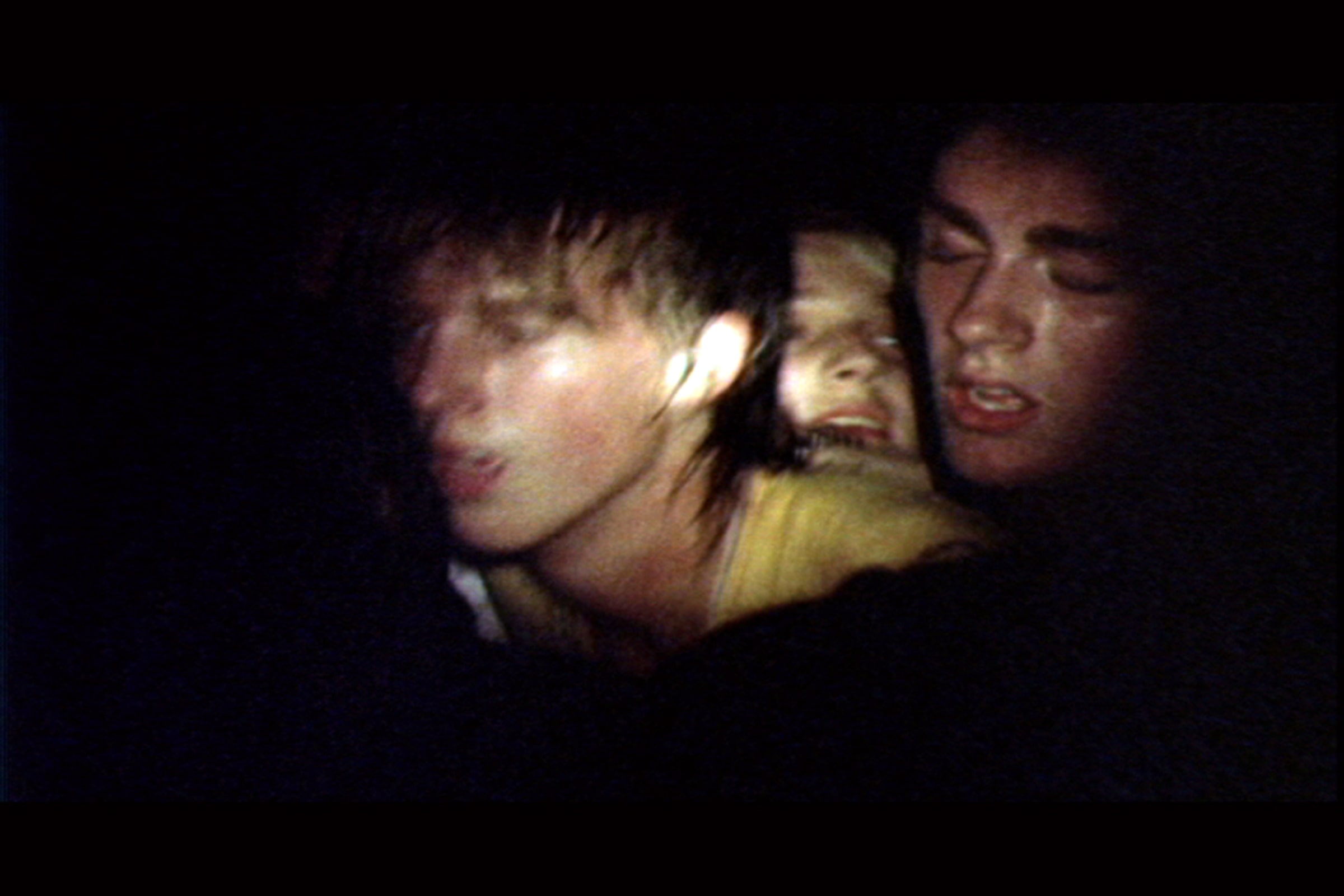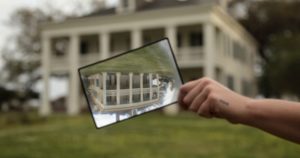Crossing Visions
— A Film selection by Fonds d’art contemporain de la Ville de Genève (FMAC)
12 October — 22 November 2018

A frequent LOOP partner, the Fonds d’art contemporain de la Ville de Genève (FMAC) presents five works by iconic international artists, whose practice reflects on cinema and its language.
Through the use of an experimental format, Rosa Barba, Mark Lewis, Miranda Pennell, Ben Russell and Salla Tykkä all question the borders between cinema and the visual arts, in this way illustrating the links, similarities and differences between the two fields. Whether technical, formal, syntactical or discursive, those issues that are typical of cinematographic practice ultimately turn into a lively subject to be explored and tested by both the artist and the viewer.

Ben Russell, Black and White Trypps Number Three, 2007
Collection Fonds d’art contemporain de la Ville de Genève (FMAC)
© Ben Russell
BEN RUSSELL (Springfield, USA, 1976)
Black and White Trypps Number Three, 2007
Film 35 mm transferred to video, colour, sound 5.1
11’30’’
The works of artist, filmmaker and curator Ben Russell mostly focus on ritual and altered states of consciousness, at the crossroads between visual anthropology, the early days of cinema and structural cinema. It is from a historical and semiological perspective that Ben Russell approaches the practice of film; he is interested in the moving image as an experimental object, as an ideal tool of identification and immersion and capable of creating a visceral or even radical acuity, as close as possible to the sensation of time and from space. Between 2005 and 2010 en Russell directed TRYPPS, a series of experimental short films mostly shot on 16mm. Conceived as an ethnographic exploration and evoking a psychedelic and phenomenological experience of the world, the series includes the hallucinatory work Black and White Trypps Number Three, filmed during a concert of the noise band Lightning Bolt in Providence, Rhode Island. Both a collective trip and the portray of an individual state of trance, the experience felt by the audience – framed in a halo of light with Caravaggesque accents –, gradually disintegrates, while the sound stretches and the images slow down, making of the film itself empirical material. [Stéphane Cecconi]

Rosa Barba, Outwardly from Earth’s Center, 2006
Collection Fonds d’art contemporain de la Ville de Genève (FMAC)
© Rosa Barba
ROSA BARBA (Agrigento, Italy, 1972)
Outwardly from Earth’s Center, 2006
Film 16mm transferred to video, colour and stereo sound
23’39’’
Be it video or film, artist Rosa Barba is interested in the very formal features of the medium, which she manipulates in order to reveal its plastic qualities, as in a self-referential process. In Outwardly from Earth’s Center, memory, landscape and fiction merge, implying a precise question: what to do when an island is adrift threatened by extinction? During a residency period on the Swedish island of Gotland, the artist started thinking about a series of possible answers to this threatening premonition, filming shots of great beauty on 16 mm and alternating them with archival footage. Open enough to allow several possible interpretations, the film can be read as an allegory of insularity, a statement on ecology, an absurd account or human satire. [Yves Christen]

Salla Tykkä, Zoo, 2006
Collection Fonds d’art contemporain de la Ville de Genève (FMAC)
© Salla Tykkä
SALLA TYKKÄ (Helsinki, Finland, 1973)
Zoo, 2006
35mm film transferred to HDV video, dolby digital
12’
In her work, Salla Tykkä reviews the legacy of cinema, exploring both its language and its formal and aesthetic qualities. An investigation of the genre of thriller and its codes, in this short film the artist immerses the viewer into a sequence where a woman is seemingly trapped in a zoo. Throughout the whole film, the influence of Hitchcock’s recurring motifs is undeniable: the blonde, chic and rather severe (not to say frigid) female protagonist with a sophisticated hairstyle, that recalls the women liked by the British director; the abundance of psychoanalytic references, such as the presence of water and the juxtaposition and struggle between two realities, – one external and the other internal –, populated by people playing underwater rugby as in an aquatic choreography; and, finally, the anxious soundtrack, that plays an essential role in the construction of the work almost converting into a character itself. To reinforce the increasingly dramatic tension, the film has no dialogue: a recurring feature in the artist’s work, it insists on the primacy of image and sound over speech. Following the woman as she runs through the enclosed space – half park and half zoo –, the artist thus touches upon several themes: the relationship between men and the nature; the reciprocity of the gaze (through the eyes of the woman and the animals, or through the camera lens); the different layers of reality; the daily visions (or drives?) incarnated by the submarine fight. [Yves Christen]

Miranda Pennell, Fisticuffs, 2004
Collection Fonds d’art contemporain de la Ville de Genève (FMAC)
© Miranda Pennell
MIRANDA PENNELL (London, UK, 1963)
Fisticuffs, 2004
16mm film digitised and transferred to video, colour and stereo sound.
11’
After studying contemporary dance in New York and Amsterdam, as well as visual anthropology at Goldsmiths University in London, Miranda Pennell turned to making film and video in 1995. Her films, however, remain strongly influenced by her primary interests, namely performance and choreography, both subject to anthropological scrutiny. Uncertain and even incongruous as they are, the rules that subject the bodies to the space, the environment and the actions generated in this context, resonate in a counterpoint with the calculated game (movement, framing …) of the camera.
Fisticuffs (which could be translated as “fist fighting”) depicts a series of characters in a typical London-pub atmosphere, where the camera follows (or not) a Western-style fight gradually transforms into a ballet as naturalistic as crazy. Between parody of American action films and social painting of a traditional pub scene, the film oscillates between real and surreal in a spirit of “nonsense” typically British. [Stéphane Cecconi]

Mark Lewis, The Pitch, 1998
Collection Fonds d’art contemporain de la Ville de Genève (FMAC)
© Mark Lewis
MARK LEWIS (Hamilton/Canada, 1957)
The Pitch, 1998
Film 35 mm transfered to video Digital Betacam, PAL, colour and stereo sound.
4’
About FMAC
The Fund for Contemporary Art of the City of Geneva (FMAC), created in 1950, was not originally intended to constitute an art collection, but rather to support local artists and decorate buildings as well as public spaces. It was only in the 1970s that the acquisition of so-called ‘mobile’ works, as opposed to works integrated in the architecture, really began.
The core mission of the FMAC is to encourage living artists. It aims to focus particular attention on emerging artists mostly in Geneva, but not exclusively, and to provide an image of art in the process of creation, by taking into account the many tendencies and practises of contemporary art.
Site-specific projects in the public domain steadily carry on the FMAC’s original purpose.
The collection can be browsed online at www.fmac-geneve.ch
The collection – videos, films, installations, CD-ROMs, web sites
Containing over 1’300 audio-visual works by visual artists, filmmakers and writers, the collection of the Media Library of the Contemporary Art Fund of the City of Geneva (FMAC) covers the international production of most of the influential artistic movements since the 1960s. Its international character, the broad range of trends represented and its historical coherence make it the richest collection of its kind in Switzerland and one of the most important in Europe.
The André Iten Fund constitutes the cornerstone of this collection. The successor to Geneva ‘s Centre for Contemporary Images (1985-2008)*, it bears the name of its founder, who passed away in 2008, and testifies to the history and the relations that André Iten built and maintained over decades with and around major artists of video art. With its 200 works, the FMAC’s video collection joins the André Iten Fund and grows in function of the latter and its history. Finally, the Christophe Chazalon Fund, a collection focusing on the polymorphous work of Chris Marker (1921-2012), brings together several hundred pieces, originals or reproductions, including virtually all the films of the French film-maker.
* Founded in 1985 by André Iten, the Centre for Contemporary Images (CIC) was an institution dedicated specifically to new image technologies: video, multimedia, internet, cinema, photography. Two biannual events punctuated its programming and regular monographic exhibitions: the Biennial of Moving Images (BIM) and Version, an event devoted to new media and IT projects. (The historical website of the Centre for Contemporary Images: www.centreimage.ch)
The Multimedia Library
Equipped with individual work stations, the FMAC’s Multimedia Library is destined on the one hand for consultation and research. A second part consists of a modular space that can host different events: programs, exhibitions, projections, performances and events devoted to highlighting these collections and subjects relating to moving images and new media. This second space, more specifically devoted to dissemination and mediation, can also serve as a laboratory and host projects designed by young curators wishing to undertake specific research on video art, its history and practice.
Occupying 150 square metres in the heart of the contemporary art district of Geneva, the FMAC’s Multimedia Library has been open since 2009. Housing both information and archives, it is an indispensable tool for exploring and teaching moving images. The Multimedia Library provides the public free of charge with a resource centre containing a video library of 1’500 works accessible in digital format (DVD), as well as a centre of documentation on video art. It also hosts the archives of Swiss video creation. Consultation is possible on the spot only (no lending or renting out).


